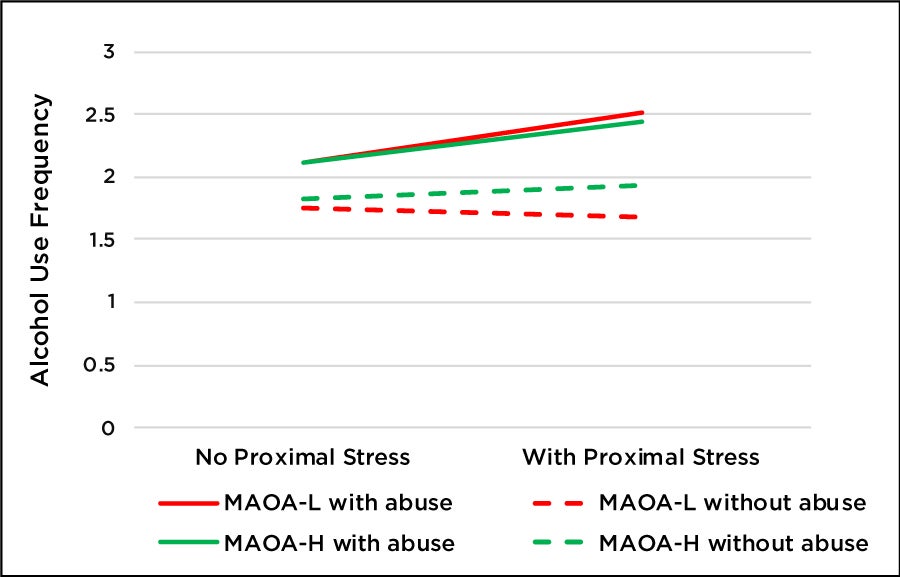

Dr. Jessica Wells earned her Ph.D. in Criminal Justice and Criminology from Sam Houston State University in 2017 and joined the Criminal Justice faculty in the School of Public Service that same year. Dr. Wells’ research focuses on the causes and correlates of antisocial behavior and associated traits. Much of this work focuses on psychological and biosocial approaches to understanding psychological traits and human behavior.
Alcohol use is estimated to cost the United States $249 billion per year and result in the death of approximately 27.9 per 100,000 individuals. Alcohol use is highly prevalent with research from the Substance Abuse and Mental Health Service Administration (SAMHSA) reporting 62.2% of males and 50.1% of females over the age of 25 having reported past month use. Although the majority of alcohol use is not considered problematic, problem drinking including alcohol abuse, dependence, and binge drinking presents serious issues for both the user and for society. Individuals engaged in problem drinking may develop physical and mental health issues including liver disease, pancreatitis, heart disease, certain cancers, anxiety, and depression. Social issues may also develop including reduced school performance and increased violent antisocial behavior. Given these effects, scholars have long attempted to understand the causes and correlates of problem drinking. Research examining why individuals engage in problem drinking can generally be divided into those that examine environmental and those that examine biological predictors.
ENVIRONMENTAL ASSOCIATIONS WITH PROBLEM DRINKING
The largest body of research on problem drinking examines the role of social environments in problem drinking. The environments that contribute to problem drinking can generally be divided into two groups: distal and proximal environments. Distal environments include exposure to various stressors early in life, usually before the age of 18. Stressors such as childhood abuse, parenting practices, socioeconomic status of a family, and parental intimate partner violence would be considered distal environmental stressors. Proximal environments include life stress that occurs relatively recent in time, usually measured in the past year. Unemployment, divorce, and death of a family member in the past year would all be considered proximal environmental stressors.
Distal stressors are regularly found to impact problem drinking behaviors. Much of this work has examined “adverse childhood experiences” (i.e., ACEs). ACEs have been found to be related to later alcohol use primarily through impacting early initiation of alcohol use. For individuals who use alcohol at an early age, the risk for later alcohol abuse and dependence is significantly higher. While ACEs are generally examined as a collection of experiences, the most impactful of these experiences is childhood abuse. Individuals that have experienced childhood abuse are more likely to use alcohol regularly and engage in binge drinking later in life. Victims of childhood abuse that experience multiple types of abuse, referred to as polyvictimization, are at the greatest risk. Individuals having experienced polyvictimization are at greater risk for heavy alcohol use in adolescence and later alcohol dependence.
Proximal stress exposure is also associated with problem drinking. Effects of proximal stress have been examined both in lab settings and in self-report studies. Studies that induced stress through increasing social anxiety (i.e., a social stress test) found that higher stress resulted in larger risk for problem drinking. Exposure to proximal stressors in daily life, such as events that result in trouble with those closest to us also increase problem drinking. More severe proximal stressors, such as becoming the victim of a crime, are also risk factors.

THE ROLE OF BIOLOGY AND STRESS SENSITIZATION
Scholars have long suggested that substance use disorders are largely driven by alteration in biological functioning. That is, dependence on a chemical substance such as alcohol is not purely a behavioral choice but rather alterations in neural functioning contribute to sustain use even despite adverse physical and social consequences of use. Because there is natural variation between individuals in functioning of chemical messengers in the brain called neurotransmitters, variation in the likelihood of developing a substance use disorder is to be expected. From a biological perspective, small genetic differences between individuals may contribute to why any two individuals may initiate alcohol use at the same time but only one develops a substance use disorder.
Although it is clear that both environmental stressors and biological variation play a role in the development of problem drinking, more interesting is the idea that these effects do not happen in a vacuum. Human lives are messy and our behavior is shaped by a large, almost imperceptible number of factors. To examine how any one factor contributes to this variation is important, but examining how these factors interact to explain problem drinking gives us a better understanding of human behavior. A useful framework for looking at this comes by way of the stress sensitization hypothesis.
While many people are exposed to proximal stress, there are subjective differences in how this stress is experienced. Two individuals experiencing the same proximal stress may feel very differently about that stress. One individual may have a difficult time coping while the other may not skip a beat in their everyday life. This may partly be explained by sensitization of the stress response system wherein some individuals have larger biological responses to stress exposure. Sensitization of the stress response system can happen through experiencing traumatic or chronic stress early in life. As such, individuals who experience traumatic or chronic distal stress will be more subjectively affected by proximal stress. Overall, the stress sensitization hypothesis suggests that this distal and proximal environment interaction may lead to variation in psychological and behavioral outcomes.
Not only does stress response vary due to interaction between environmental risk factors, but scholars have hypothesized that genetic variation may also contribute to this interaction. Certain genetic polymorphisms, or small differences in genetic codes between individuals, can impact the ways in which we experience the world. Individuals with certain alleles (versions of polymorphisms) may be more resilient to this stress sensitization process. In other words, human behavior can be explained by an interaction between genes, distal environments, and proximal environments (GxExE). The impact of any of these elements is contingent on the presence or absence of the other two elements.
Empirical tests of this hypothesis on substance use are just beginning to emerge. For example, recent research examined the impact of two genetic polymorphisms with an impact on the serotonin system, 5-HTTLPR and MAOA, on the stress sensitization process in understanding trajectories of alcohol use behaviors. Using a nationally representative sample of the U.S. (National Longitudinal Study of Adolescent to Adult Health), the author examined a GxExE hypothesis on alcohol use trajectories from adolescence into early adulthood. In males, the effect of proximal stress on alcohol use frequency was greater for those that had experienced the distal stress (childhood abuse), but the difference between the effect of distal stress on proximal stress’ effect on alcohol use frequency was greater for those with the MAOA-L allele.

POLICY
There is a great amount of research that is still needed in order to parse out this GxExE effect. Currently, efforts are underway to conduct this research. Once more light is shown on this issue, we may be better able to understand and treat individuals with substance use disorders. Given the variation between individuals in how stress is related to alcohol use and problem drinking, our efforts to diminish problem drinking that are centered on punishment and deterrence may be somewhat misguided. Many individuals cannot simply will themselves into perceiving lesser effects of stress without comprehensive, rehabilitative approaches designed to help them do just that. Incarceration alone for low level offenses may disrupt the life-course of offenders, leading to heightened unemployment and familial issues. Without treatment during incarceration, these offenders may return to their communities facing a great deal of proximal stress and with few tools to cope with this proximal stress. This may, in turn, increase the likelihood of relapse into problem drinking behaviors. In fact, incarceration alone may worsen substance use and criminal justice system involvement.
The treatment that is delivered during incarceration, however, may have a lasting impact on reducing problem alcohol use. Given the complex interconnected nature of the relationship between stress and problem drinking and drug use, the importance of utilizing evidence-based practices (EBP) is necessary in order to reduce the harm of this behavior to Idahoans, to reduce the harms associated with problem drinking and drug use societally, and to reduce the ultimate costs of reincarceration of these offenders multiple times across their lifespan. Programs targeted toward stress reduction and coping, such as mindfulness-based relapse prevention, have shown some success in reducing alcohol and drug use.
In Idaho, EBP is being utilized. At the Ada County Jail, some offenders with alcohol and drug addiction issues undergo TAP-19 programming developed by SAMHSA. Idaho Department of Corrections is also utilizing a variety of EBP programs to help address this wide-spread issue. Despite the availability of this EBP programming for offenders, many individuals that need such programming are not receiving it. Continuation of such services are essential in lessening the social and financial burden of substance use. Despite the long term benefits, operation of EBP for substance use can appear costly in the short term as the administration of these service and implementation of advanced EBPs require sufficient funding to deliver programs with maximal effectiveness. Ultimately however, support for such programming results in better substance use outcomes for offenders and ultimately in a healthier and safer Idaho.